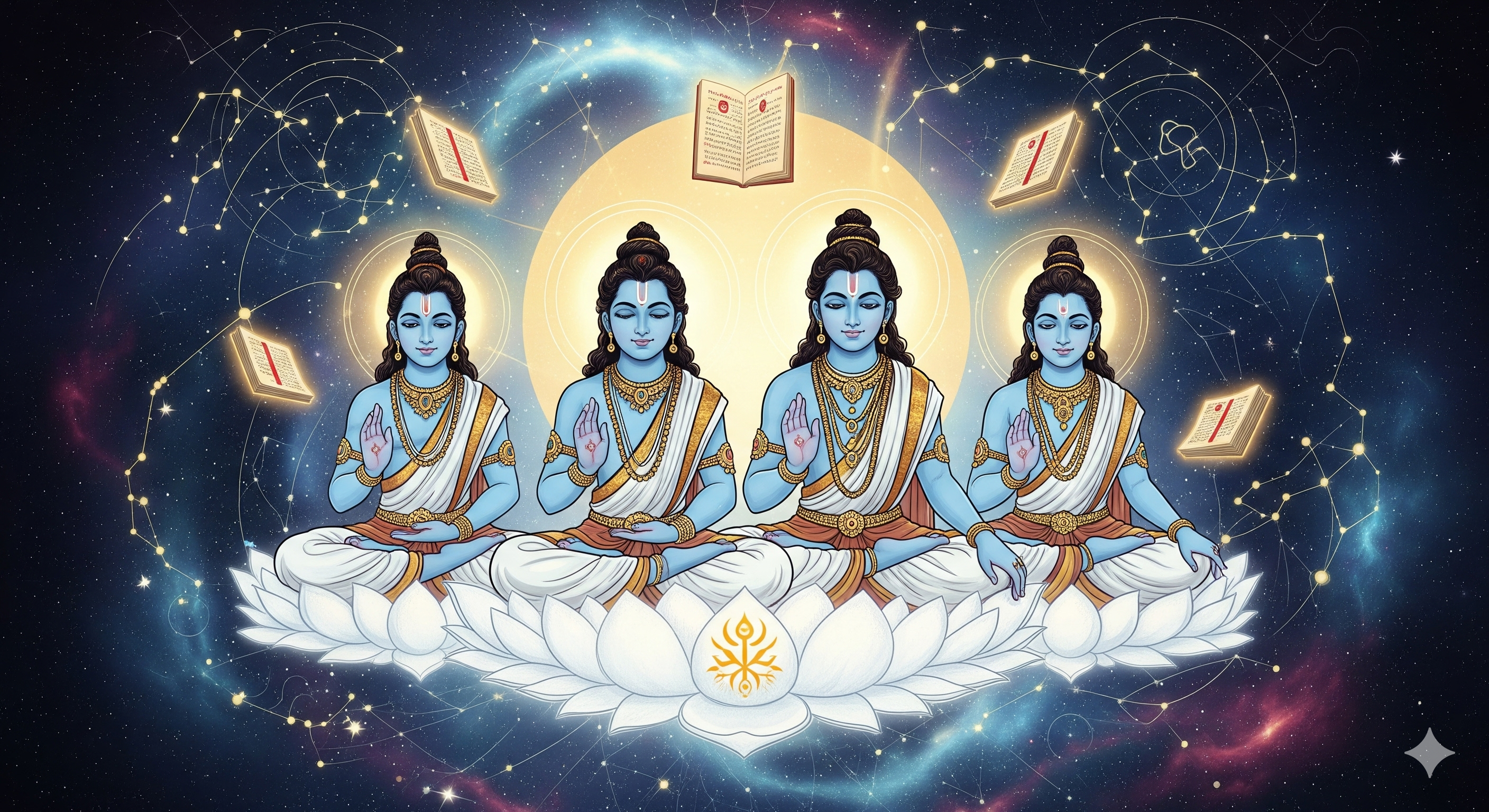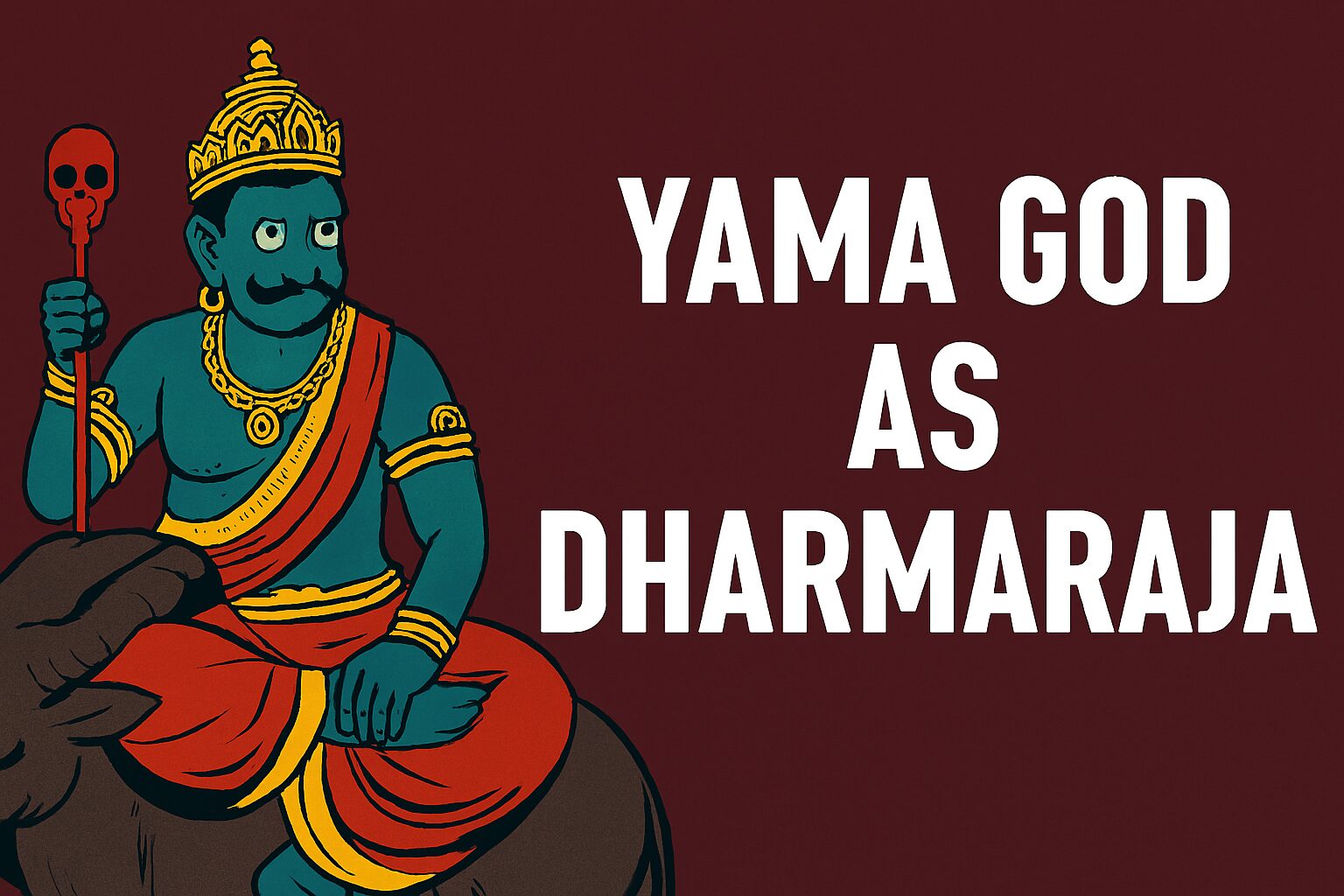In our journey to truly become a Modern Sanatani, it is important to know our history and the onset of our worlds in as much depth as possible and this journey starts by learning about facts such as the First Four Sons of Brahma. Based on my readings, I have accumulated as much wealth of knowledge as God planned to flow through me. My attempt is to give you all stories about one character in one place. Increase your knowledge base with this piece of information with me today:
Who were the Sanat Kumaras?
According to the Vishnu Puran, the first God created was Vishnu. At the beginning of time, laying in the Ocean of Milk atop was Narayana. As he woke up from his sleep, out of his navel, came out a lotus on which Brahma was seated. As soon as Brahma opened his eyes, he asked Vishnu who he was, what was his role and why was he given birth. The puranas highlight the explanation of his origin being dictated by Narayan. Brahma’s soul purpose was to figure out a way to populate the Earth and find a way for the creation of an ideal world.
Birth of the Four Kumaras
As Brahma had little clue on where to start, he created four boys/infants from his mind (They were also called the ancient ones, the first four sons of Brahma, the four Kumaras or Sanakadi Rishis.). The boys were very young (in many texts, they are indicated as beings born as infants). They looked at Brahma and asked him the reason for their birth. Brahma gave them the task to reproduce and populate the world. The four kumaras refused. It is often said that since the Kumaras were born before the sense organs were created, they did not comprehend the need for population.
Characteristics of the Four Kumaras
The Kumaras highlighted that they did not want to put themselves in the cycle of birth and rebirth. They wanted to spend their lives seeking the ultimate truth, gain knowledge and learn the importance of life. The Kumaras were born with the understanding of Karma and how its circle can keep running once you step into it. They decided to step out at the beginning and continue their journey as true seekers.
The names of the Four Kumaras or the First Four Sons of Brahma are – Sanaka, Sanandana, Sanatana and Sanatkumara.
Some of the main characteristics of the Sanat Kumaras are:
- Took a Vow of Eternal Celibacy – Brahmacharya
- They went against the wishes of Brahma to become creators of Life – Even though they were the first four sons born from Brahma’s mind.
- They took the responsibility of spreading knowledge throughout the spiritual and the materialistic world later on
- They studied Vedas in depth and understood the truth behind the world and its creation from the onset. They learnt the Vedas at the age of 5 or 6 years.
- They became the greatest yogis, siddhas and beings.
- As they reached enlightenment at a very young age, they were able to remain children forever and maintain their youth. Every time you see an image of Sanat Kumaras, you will always find them painted as young boys of not more than 5 years of age.
- They always travelled together
- Each one of them had a different feature that ruled their personality
- They could never grow old and maintained their joyful nature.
- They were called the ancient ones, most knowledgeable and respectable rishis in the sansar.
- They remained naked always as they never related themselves with the material world.
The Sanat Kumaras or the First Four Sons of Brahma were an embodiment of Purity. As they refused to help Brahma create the world, it is often said that the anger experienced by Brahma was so high that it gave birth to Shiva at that very moment. The Shaivists might not agree with this particular train of thought. The Shiv Puran states that it was Lord Shiva who gave birth to the other two Gods of our universe. The opinions may differ from one sect of believers to the other but the roles of every God remain the same throughout the different religious texts.
Coming back to the Sanat Kumaras, the ancient texts highlight that the sensory organs in every living being are the cause of the majority of the problems that they face. As the sensory organs were absent in the Kumaras, it was easier for them to renounce the material world or the responsibilities and walk the path of being true God Seekers.
An Interesting Story around the First Four Sons of Brahma
Although there are very few stories surrounding the four sanat kumaras, this story is one of the most important ones that shaped the history of our world as we know it today. As the four sanat kumaras were roaming around in the universe, they decided one day to visit Narayana and take some knowledge from him. Their journey towards the vaikunth was halted by Jaya and Vijaya.
These two individuals were the gate keepers of Vishnu’s abode and they ensured that only the worthy souls were able to reach God himself. As the 4 sanat kumaras tried to enter the sacred abode, Jaya and Vijaya stopped them and asked them to come later as the God was in a deep slumber. They were not aware of the power and the importance of the 4 rishis. This was their biggest mistake.
For being stopped at the gates and being refused entry to the abode, the 4 Kumaras cursed Jaya and Vijaya to take 7 births on the Bhulok and left the place. As the two gatekeepers were one of the biggest worshipers of Narayan, they immediately panicked. Taking births on Bhulok meant their separation from their God. They could not even imagine how they would be able to survive.
The two gatekeepers immediately run towards Narayan and share the story in its entirety. They beg God to lift the curse. But Vishnu knew a curse by the 4 Kumaras could not be broken. But, he could ask them to alter the curse. So, the Jaya and Vijaya are presented with two options:
- Taking 7 births as the best friends of Vishnu when he reincarnates and takes birth on Bhulok
- Taking 3 births as the most devious and evil enemies of Vishnu when the reincarnations happen
Jaya and Vijaya immediately took the second option. They were ready to be ranked as the most devious beings in the world if it meant that they could return to the service of their God sooner. As it turns out, the curse came to pass. The three births taken by Jaya and Vijaya were:
The first most prominent enemies of Vishnu on earth were the two brothers – Hiranyakashipu and Hiranyaksha. Hiranyakashipu was the father of Prahlad and known for being one of the tyrannical Asura rulers known. To kill him, Narayan took the Narsimha Avatar.
Hiranyaksha was the mischievous Asura king who had submerged Bhudevi (earth) under water and terrorised the three worlds. To kill him, Narayan took the Varaha avatar.
The second prominent enemies of Vishnu were born in the Treta Yug – Ravana and Kumbhkaran. The two brothers were from the Rakshas community and gained a big number of boons from Lord Shiva and Brahma with their intense Sadhana and spiritual practices. Their arrogance and power terrorised rishis and other beings on earth. To kill them, Narayan took the Ram Avatar.
The third combination of enemies of Vishnu were Shishupal and Dantavakra. Both of them had immense enmity with Krishna because of his actions of killing Kansa and Salva. It is with the Krishna Avatar in the Dwapar Yug that these third set of enemies were killed.
With the end of the Dwapar Yug, Jaya and Vijaya finally got the liberation that they needed. Once and for all, they returned back to the vaikunth, awaiting the return of their God.
The Sanat Kumaras or the First Four Sons of Brahma had immense power but they never used the same for bad deeds. It is said that every action and reaction is all pre-destined and designed by God himself for the working of the Kaal Chakra.
You and I, we all have destinies designed by God as well. But, we also have free will that allows us to acquire good or bad karma. Every action taken can help us change our destiny and improve our future. It is all about the growth of the soul. As human beings, it is our responsibility to use this birth to acquire the good karmas and cancel out the bad ones. The soul craves for you to make the right choices and work towards liberation.
Every step counts. Let’s start somewhere!
If you loved reading this, you might also like to check out this article: Yama God





